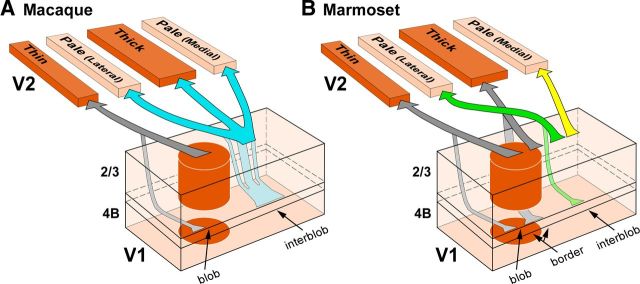Figure 1.
Parallel pathways between V1 and V2 CO compartments in macaque and marmoset. Arrows indicate V1 projections to V2, with arrow thickness indicating the relative density of projections. Only projections to pale stripes are shown in color as these projections are the focus of the present study. Projections to other V2 stripe types, which were not investigated in this study, are shown in gray. A, The bipartite scheme of V1-to-V2 projections in macaque proposed by Sincich and colleagues (Sincich and Horton, 2002a; Sincich et al., 2007, 2010). According to this model, neurons throughout the depth of a blob column (predominantly in layers 2/3, and less so in layer 4B) project to thin stripes (gray arrows; sparse inputs from layers 4A and 6 also exist but are omitted in the figure), while neurons throughout the depth of an interblob column (predominantly in layers 2/3, and less so in 4B) project to both thick and pale stripes (cyan arrows; sparse inputs from layers 4A and 6 are omitted). In this model, all pale stripes receive V1 inputs from the same V1 layers. B, The quadripartite scheme of V1-to-V2 projections in marmoset proposed by Federer et al. (2009). In this model, neurons in blob columns (predominantly in layers 2/3, and less so in 4B) project to thin stripes (left pair of gray arrows; sparser inputs from 4A and 6 exist, but are omitted); neurons at the border between blobs and interblobs (predominantly and equally from layers 2/3 and 4B) project to thick stripes (right pair of gray arrows; sparser inputs from layers 4A and 6 are omitted). In this model, all pale stripes receive the strongest projection from interblob neurons in layers 2/3 (dark green and yellow arrows) and a smaller projection from layer 4A (data not shown), but while pale lateral stripes additionally receive a contribution from layer 4B (light green arrow), pale medial stripes do not receive inputs from layer 4B or 6.

